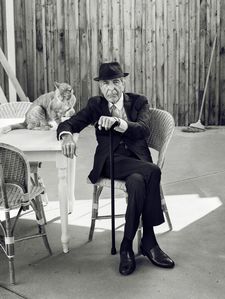 |
| Dan Geller on Leonard Cohen: ‘Leonard is a very very clever writer. I believe someone had asked James Joyce about Ulysses, which is, you know, famously impenetrable …” Photo: Cohen Estate |
The 21st edition of the Tribeca Film Festival hosted a special New York première screening of Dayna Goldfine and Dan Geller’s poetically keen Hallelujah: Leonard Cohen, A Journey, A Song, with an original score by John Lissauer (executive produced by Jonathan Dana, Morgan Neville, Robert Kory, Michael Drews, Robin Sagon) at the Beacon Theatre, followed by a Leonard Cohen tribute concert with Judy Collins, Amanda Shires, Sharon Robinson and Daniel Seavey. The documentary is dedicated to the distinguished music producer Hal Willner (recently Ethan Silverman’s Angelheaded Hipster: The Songs of Marc Bolan & T. Rex and the Lou Reed: Caught Between The Twisted Stars exhibition).
Through performance clips by Leonard Cohen, John Cale, Jeff Buckley, and kd lang, and insightful on-camera interviews with Larry ‘Ratso’ Sloman (Rolling Stone reporter in Martin Scorsese’s Rolling Thunder Revue with Bob Dylan), fashion photographer Dominique Issermann (whom Leonard Cohen called the love of his life), Shrek co-director Vicky Jenson (on the Jeff Buckley, Rufus Wainwright Hallelujah debate), Glen Hansard (Academy Award for Best Original Song with Markéta Irglová for Falling Slowly in John Carney’s Once), Clive Davis (president of Columbia Records when Cohen was signed), Nancy Bacal (his childhood friend), Adrienne Clarkson, Brandi Carlile, Eric Church, Regina Spektor, Amanda Palmer, Joan Wasser, Janine Dreyer Nichols and Susan Feldman (St. Ann’s Warehouse), Dylan, Willner, Robinson, Collins, Lissauer, plus well-chosen artefacts we gain a fuller picture of the revered artist and the ongoing evolution of his creation Hallelujah.
From New York City, Dayna Goldfine and Dan Geller joined me on Zoom for an in-depth conversation on Hallelujah Leonard Cohen, A Journey, A Song.
Anne-Katrin Titze: Hi! Hallelujah! You will probably never get it out of your head during your lifetime!
Dayna Goldfine: I still like it!
AKT: You dedicate the film to the memory of Hal Willner, who was your music producer on this film. Last week [on June 7] I was at a press preview at the Library for the Performing Arts for a new exhibition on Lou Reed. I see you are nodding.
DAYNA: We heard that Hal’s office was reconstructed there, right?
AKT: Exactly.
DAYNA: We spent so many completely delightful, sometimes exasperated hours sitting in that office. If you looked at it you could see how chock-full of amazing, once-in-a-lifetime things it is. That office is embedded in our memories.
AKT: Are you in New York?
Dan Geller: Right now we are in a glorious hotel room because our film was at the Tribeca Film Festival last night [June 12] at the Beacon Theatre, which is historically so important, not only in terms of Hallelujah the song, where John Cale first heard Leonard performing it, and then John Cale performed it, but also where Leonard’s comeback tour really officially launched.
He had been doing preview dates in Canada in small venues. So to play the film there and to have a live concert with Judy Collins and Sharon Robinson and Amanda Shires and Daniel Seavey - it’s worth doing Zoom calls from a hotel bedroom at this point.
AKT: What a perfect location. And the exhibition at the library is open to all now, I can forward you my feature, if you’d like.
DAYNA: Yes, please. Who did you interview? Did you speak to Laurie?
AKT: Actually, I had had a conversation with Timothy Greenfield-Sanders earlier, whose photos are in there. Ed Bahlman of 99 Records spoke with him about Lou. Of course Laurie was at the press preview, so I have pictures of Laurie as well.
DAYNA: Oh great!
 |
| Dayna Goldfine on Larry ‘Ratso’ Sloman: “Ratso’s initial claim to fame was that he went on the Rolling Thunder Tour with Bob Dylan …” Photo: Dan Geller, courtesy of Sony Pictures Classics |
DAN: There’s a funny Lou moment. We had been under the misimpression that Janine Nichols was the one who first played Hallelujah for Jeff Buckley. We were at a private little listening party for the posthumous release of Lou’s boxed set of CDs and I happened to be sitting next to Susan Feldman at some point, talking about the movie. We were still in the middle of shooting it actually.
And I said “I can’t believe that your Artistic Director [at St. Ann’s] played Jeff Hallelujah for the first time.” And Susan blurted out “She did not! I did it!” And that’s when we decided, okay, we’re going to go back and we’re going to shoot a double interview with them, which I think is a charming interview at St. Ann’s Warehouse.
AKT: There are so many great interviews, old and new, I have to say. The archival and what you shot, woven together into a mix that gives voice to the different interpretations and different ideas. You did not want to streamline it at all, did you?
DAYNA: No, no, because I don’t think there is one interpretation. I think as Eric Church says, the thing that’s so great about the song is that it means a zillion different things and none of them are wrong.
AKT: I have to ask you about the third line. “You don’t care for music, do ya” or “do you,” depending on the performance. Who for you is that “you” Is it the Lord? David? Me? Is he talking to me?
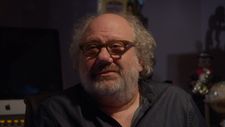 |
| Esteemed music producer Hal Willner in Hallelujah: Leonard Cohen, A Journey, A Song Photo: Dan Geller, courtesy of Sony Pictures Classics |
DAN: That’s the power of the song. I mean. Leonard is a very very clever writer. I believe someone had asked James Joyce about Ulysses, which is, you know, famously impenetrable, in some interview, where he said “Would you like me to shed any obscurity on it for you?”
AKT: Ha!
DAN: I think yes, the answer to is it God, is it David himself, is it the listener? It’s all three, however the light reflects off it for you.
DAYNA: If you’re thinking about who Leonard is referring to, is it a woman who he was trying to impress? That again is the beauty of the song. That’s why we could spend so many years working on this film and never be bored. That song gets richer the more you examine it.
DAN: It’s also an in-joke for songwriters and musicians. Some of the lines are shoptalk, and he says you don’t really care about that, do you. It’s funny he gives away the secret of a particular chord progression and makes a joke out of it. It’s brilliant, it’s so funny.
AKT: You have these treasures of notebooks. As viewers we are reminded of where we are now. Who Is is ever looking at old drafts of documents on the computer? This kind of writing mostly disappeared and with it the emotional traces. Tell me about the notebooks and your feelings seeing them!
 |
| Dayna Goldfine on Hal Willner’s studio: “If you looked at it you could see how chock-full of amazing, once-in-a-lifetime things it is.” Photo: Anne-Katrin Titze |
DAYNA: First of all, the first time that we heard about them must have been during our interview with Ratso. It was the very first interview we did for the whole film in the summer of 2016. After Leonard passed away we were in communication with Robert Kory, the executor of the estate and Leonard’s onetime manager. Every time we sat down with him, we’d say “Do these notebooks actually exist?” And it took him years to admit they did. Then it took him months after that to show us one. And then it took him a few more months after that to allow us to actually touch that one.
It was an evolving trust exercise. For me the most exciting thing that happened, and it happened several times, was - because we got access so late in the process and in the editing process even - was turn the page of a notebook and actually read with your own eyes a line that you had heard Leonard reading to Ratso, for instance, when they were going over a song. It just gives you chills.
AKT: And now you can touch it! I remember going to Sotheby’s because they had a first edition of a Brothers Grimm book from 1812 and holding it in my hands. That’s the great thing about auction houses, it felt the way you are describing. I want to talk about the Ratso interview from 1992 and the footage from the diner “Fine Food Reasonable Prices”.
DAYNA: I know, ha!
DAN: It’s crazy! It was done for an electronic press kit for Sony around the release of the album Future. It was staged in a closed, dilapidated diner that they probably redressed. It was shot in an odd way, there was a camera across the street. For chunks of the takes from across the street, there’s a delivery van, so you just see the side of a delivery van. I wish there were more of the interior coverage.
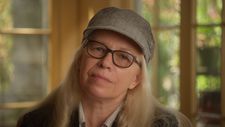 |
| Dominique Issermann: “Leonard was often starting with this song. First thing, coffee, then working on Hallelujah.” Photo: Dan Geller, courtesy of Sony Pictures Classics |
AKT: There’s a woman walking by inside who resembles Joni Mitchell.
DAYNA: Ah, that’s true.
DAN: The subject matter of that interview. Ratso and Leonard at that point having known each other 20 years dive deep. They laugh and for Leonard to have the audacity to say do you think most writers take this much care with a pop tune? The relationship, the trust they had in each other is what makes that footage work so well.
DAYNA: But it was really hard to edit with because on the one hand the audio content was amazing. But because the director in 1992 shot that footage with the intention of doing a super-artsy three-minute almost like montage electronic press kit thing, it was not shot for our purposes. Mostly it was an incredible gift but there were times when we were pulling our hair how we’re going to cut this. But it doesn’t really matter because the material is so juicy.
AKT: It’s so beautiful. In the beginning I actually thought, is this the best CGI reconstruction I have ever seen in a documentary? Did you place them in this diner? I was thinking David Lynch thoughts . Along the lines of “I had a dream about this place.” [remember Mulholland Drive?]
 |
| Jeff Buckley’s cover of Hallelujah was not featured in Shrek, John Cale's was Photo: Jack Vartoogian/Getty Images |
I want to get to the fact that Cohen spent six years at the Mt. Baldy Zen Center and then left. You brought up James Joyce, Dan. I was reminded of the tale The Selfish Giant by Oscar Wilde in which the Giant meets his friend, the Cornish Ogre, and they have a conversation of seven years, and then he leaves because they ran out of conversation. That’s how it comes across in your film.
DAN: It’s funny you just had me thinking that the Zen way would be he’d run out of things not to say!
DAYNA: I love how Leonard said, “You know, I just told Roshi it’s time to go down the hill for a little while.” And it wasn’t that he was no longer depressed. I think he just felt that he had done the work he felt he could do up there and it was time to go down. It was actually a few years after that that the depression lifted.
AKT: There is a German satirist by the name of Ludwig Thoma, who was born in 1867 and died in 1921. He wrote a satirical sketch about a porter at the Munich train station who goes to heaven. There in heaven he has to sing Hallelujah all day. There is an animated short of it from I believe the 1960s. He gets a harp, is stuck on a cloud and has to play Hallelujah all day. He becomes more and more furious and hates it so much until he is sent back. I can get the link to you.
DAYNA: I would love it.
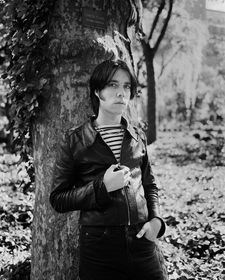 |
| Rufus Wainwright’s cover of Hallelujah was featured on the Shrek album Photo: Ken Schles |
DAN: That’s brilliant.
AKT: So back to my first question, how much are you haunted by Hallelujah?
DAN: Certainly it’s in my head in a deep way and I play it on the guitar. But because there are 22 other Leonard Cohen songs in the movie, even though there’s a lot of Hallelujah, it’s living with these other songs, that really has stuck with me. If It Be Your Will, Tower of Song, Bird on the Wire, all these are in my head all the time. So I’m not sick of Hallelujah, and for that matter I’m not sick of any of those songs because if a melody starts into my mind and the lyrics then flow right behind it the poetry comes back in again.
I’m thinking about this just now. Leonard’s songs do tend to come unannounced, as a listener. You don’t need to recall them deliberately that often one would need to with a book of poetry. The melodic and rhythmic nature of a song just shows up unannounced and with Leonard’s work carries the lyrics right along with them. So we are constantly reexamining these lyrics, which are so wonderful and deep and multi-faceted.
DAYNA: Also every cover of that song feels like its own entity. If I feel like listening to a kd lang version, it’s completely different from the version that Leonard did in his final show. Listening to Brandi Carlile I really do get from her that aching exploration of spirituality and carnality that she talks about. I’m so not tired of the song.
AKT: I like the part explaining the song versions for Shrek. Is it still Shrek now, you think, that most people know the song from?
DAYNA: You can kind of figure out the generation of the person you are telling about this movie. Because there’s now a new generation which when you say Hallelujah, they say “Oh, the Sing!” from the animated film Sing. Because Jennifer Hudson sang Hallelujah in Sing.
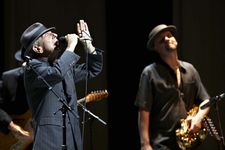 |
| Dan Geller on Leonard Cohen’s songs: “We are constantly reexamining these lyrics, which are so wonderful and deep and multi-faceted.” Photo: courtesy of Leonard Cohen Family Trust |
DAN: Or pick your Idol franchise. Whoever was singing it most recently. What was wonderful about last night was having Daniel Seavey be one of the performers who performed live after the movie. He’s young and has a fanbase that I suspect many many many people don’t know about Leonard Cohen. We had on stage at the Beacon Theatre Judy Collins in her eighties, Sharon Robinson who is an adult and Amanda Shires who must be in her thirties at this point and Daniel Seavey who is in his twenties - all connecting to Leonard Cohen and doing this live on stage,
I’d be hard-pressed to think about many other songwriters whose works can stand up in this case for over sixty years and appeal to so many generations still. That’s a lot of responsibility on the two of us when we were trying to put the movie together to communicate that aspect of his timelessness. He said in an interview that’s not in the movie, he said “I think my songs are like Volvo automobiles.” They’re built to last, you at least get twenty or thirty out of it.
AKT: I grew up with Volvos. That’s a good analogy. I have one final question about Ratso getting his name. Is that because of Midnight Cowboy and Dustin Hoffman’s character of Ratso Rizzo?
DAYNA: Ratso’s initial claim to fame was that he went on the Rolling Thunder Tour with Bob Dylan and he wrote this fabulous book called On the Road with Bob Dylan. In the middle of that tour, he was quite unkempt, he was like an early-twenty-something reporter, no money, who was mooching his way along the tour in the hopes of writing what ultimately became On the Road with Bob Dylan. One morning he rolled out trying to figure out how he was going to get from stop A to stop B. He was in front of the hotel and Joan Baez walked out and saw him and said “Oh my god, you look just like Ratso Rizzo.”
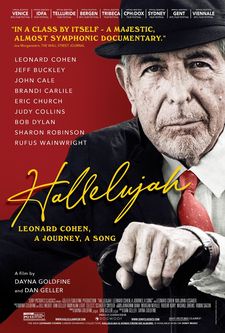 |
| Hallelujah: Leonard Cohen, A Journey, A Song poster |
DAN: It was right at the time that Midnight Cowboy had come into theaters.
DAYNA: And then it just stuck. It’s a real snapshot of that moment in the Seventies when this completely random tour that was thrown together by Bob Dylan drove around on a bus from place to place.
AKT: The Martin Scorsese film [Rolling Thunder Revue: A Bob Dylan Story by Martin Scorsese] …
DAYNA: Yes, but that’s a very fictionalized version.
AKT: Exactly, very, very fictionalized. Thank you so much for your entertaining film!
DAYNA: Thank you so much for watching!
DAN: It was enjoyable.
Hallelujah: Leonard Cohen, A Journey, A Song opens at Film at Lincoln Center and Film Forum on Friday, July 1. Q&As after the 6:00pm screenings on July 1 with Larry ‘Ratso’ Sloman and July 2 with Author/Consulting Producer Alan Light, moderated by Chris Molanphy of Slate - Walter Reade Theater; At Film Forum - Q&As after the 8:00pm screening on July 1 with Alan Light, 5:30pm on July 2 with Larry ‘Ratso’ Sloman, and 8:00pm on July 7 with Alan Light.









